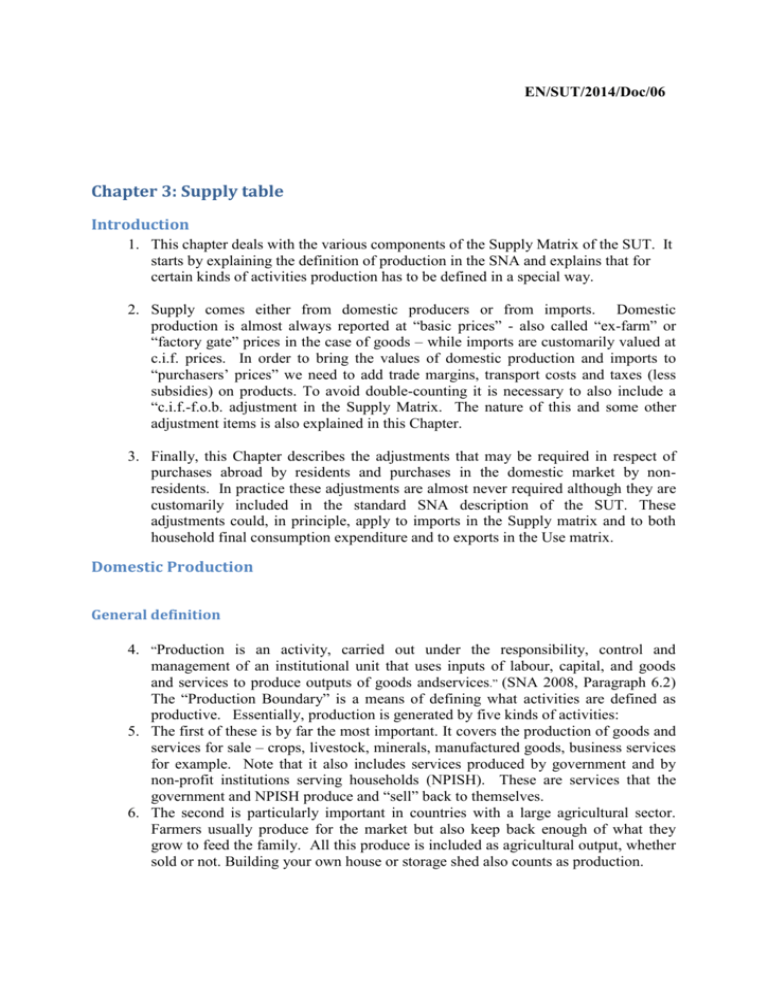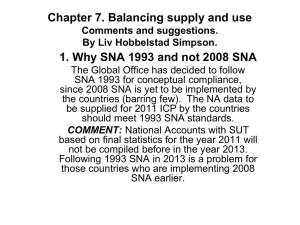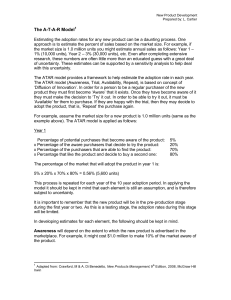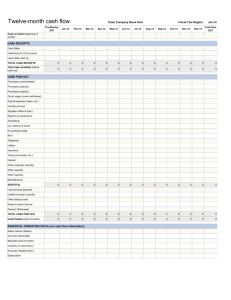English - African Centre for Statistics
advertisement

EN/SUT/2014/Doc/06 Chapter 3: Supply table Introduction 1. This chapter deals with the various components of the Supply Matrix of the SUT. It starts by explaining the definition of production in the SNA and explains that for certain kinds of activities production has to be defined in a special way. 2. Supply comes either from domestic producers or from imports. Domestic production is almost always reported at “basic prices” - also called “ex-farm” or “factory gate” prices in the case of goods – while imports are customarily valued at c.i.f. prices. In order to bring the values of domestic production and imports to “purchasers’ prices” we need to add trade margins, transport costs and taxes (less subsidies) on products. To avoid double-counting it is necessary to also include a “c.i.f.-f.o.b. adjustment in the Supply Matrix. The nature of this and some other adjustment items is also explained in this Chapter. 3. Finally, this Chapter describes the adjustments that may be required in respect of purchases abroad by residents and purchases in the domestic market by nonresidents. In practice these adjustments are almost never required although they are customarily included in the standard SNA description of the SUT. These adjustments could, in principle, apply to imports in the Supply matrix and to both household final consumption expenditure and to exports in the Use matrix. Domestic Production General definition 4. “Production is an activity, carried out under the responsibility, control and management of an institutional unit that uses inputs of labour, capital, and goods and services to produce outputs of goods andservices.” (SNA 2008, Paragraph 6.2) The “Production Boundary” is a means of defining what activities are defined as productive. Essentially, production is generated by five kinds of activities: 5. The first of these is by far the most important. It covers the production of goods and services for sale – crops, livestock, minerals, manufactured goods, business services for example. Note that it also includes services produced by government and by non-profit institutions serving households (NPISH). These are services that the government and NPISH produce and “sell” back to themselves. 6. The second is particularly important in countries with a large agricultural sector. Farmers usually produce for the market but also keep back enough of what they grow to feed the family. All this produce is included as agricultural output, whether sold or not. Building your own house or storage shed also counts as production. 7. Authors, film producers and musicians are also producers. The SNA treats their output as a kind of capital asset. The original manuscript or piece of music will go on producing an income for the producer over several years. 8. When you live in a flat or house that you own, the SNA considers that you are an entrepreneur producing housing services and selling them back to yourself. 9. Finally, households can produce domestic services which they “sell” to themselves by employing cooks, butlers, gardeners and body-guards. Production is not always the same as sales 10. For services, production and sales are always the same. A restaurant's production is what it gets from its customers for the meals it serves: the output of an airline is the value of the tickets it sells. But for goods, some of what is produced may not be sold immediately. It goes into stocks. This means that goods output may be smaller or greater than its sales. It will be smaller if it is running down its stocks of finished goods and larger if it is accumulating more stocks of goods for sale at a later date. For most kinds of activities production can be calculated as sales plus the increase in stocks of finished goods, where the increase can be either positive or negative. Special cases in defining and measuring gross output 11. Government and NPISH gross output is valued as the “costs of production”. These are listed below: Compensation of employees is the biggest item. It consists of wages and salaries and allowances in cash and the value of any income in kind – free or subsidized housing, food and meals, transport to and from work. An important point to notice here is that wages and salaries include employer’s contributions for social security – health care, unemployment insurance and pensions for example. Mostly governments provide these social benefits without making actual contributions to a social security fund. In this case the national accountant has to estimate what the government would have to have paid into a fund in order to finance the benefits that employees actually receive. This amount is then added to wages and salaries to obtain compensation of employees. Income in kind is an important part of compensation of government employees in many African countries. For example, school teachers, hospital workers and soldiers are often provided with free accommodation both for themselves and their families. Income in kind is valued at the cost to the employer of providing free housing and other benefits. Intermediate consumption includes office stationery, electricity, rent and other current cost of running government offices, hospitals, schools, police forces and armies. Consumption of fixed capital (CFC) is the decline in the value of government fixed assets through wear and tear and through obsolescence. Government computers, vehicles and office buildings, hospital and school equipment and so on are being used up in the process of producing government services. The national accountant must include this “using up of capital” in the cost of producing government services even if governments themselves do not always show it in their accounts. Many countries do not include this in government expenditure even though they claim to be implementing the SNA. A 2013 survey by the AfDB1 showed that a dozen countries do not estimate this item, including some large countries such Nigeria, Mozambique, Senegal, Uganda, and Tanzania. Omission of CFC leads to underestimation of GDP. (see Chapter 8 for more discussion of this item.) Operating surplus is usually zero or negligible. It may include the operating surplus of restaurants or bookshops in museums. Taxes and subsidies on production are usually zero for government but they may apply for the output of NPISH. 12. The output of retailers and wholesalers is not the total value of sales but rather the margin. 13. The margin is the difference between the value of goods sold and what the seller would have to pay to replace those same goods at the moment when the sales takes place. When prices are rising the replacement price of goods bought for resale will be higher than the price actually paid for those goods. For goods that remain in stock for short periods such as fresh food, it may not be necessary to adjust for the increase in price of goods bought for resale, but for goods that remain in stock for long periods, the prices of goods bought for resale should be revalued to replacement prices to avoid overstating the margin by including a holding gain. 14. The margin measures the cost of the services the retailer or wholesaler provides by storing goods for resale, keeping them in good condition, displaying them in an attractive fashion and providing advice to customers. 15. Here are some examples of how we calculate output of trade: A trader buys goods for resale for 50 and has sales of 75. Assuming there is no change in stocks of goods for resale and no change in the prices of goods for resale, the output will be 75 minus 50 = 25. Twenty five is the margin on the goods sold. A trader does not buy any goods for resale but sells 100 this year. Those sales must have come out of the stock purchased in an earlier year. In this case the increase in stocks for resale will be a minus figure - minus 60 which is the replacement cost of the goods taken out of stock for resale. The gross output is then 100 + (minus 60) = 40. Forty is the margin on the goods bought in an earlier period for resale but that were actually sold in the current year. These goods are valued at the prices that will have to be paid to replace them in the current year. A trader buys goods for resale for 70 and over the year the value of the stock of goods for resale increases by 10. Half of the increase (5) is due to inflation. If sales are 80, gross output equals 80 minus 70 plus 5 = 15. Fifteen is the margin on the goods bought for resale at replacement prices. 16. Bank output is the value of bank services sold (usually quite small) plus the difference between the interest paid to depositors and the property income earned by banks (usually very big). African Development Bank, “Situational Analysis:The Reliability of Economic Statistics in Africa focussing on National Accounts”, May 2013, Tunis 1 17. The difference between interest and other property income received and interest paid to depositors is now called FISIM – Financial Intermediation Services Indirectly Measured. In the older versions of the SNA it was called “Imputed Bank Service Charges” and was calculated in the same way as FISIM. FISIM is not new. It is just a new name. (The 1993 SNA introduced a new rule that, if feasible, FISIM should be recorded as a purchase of a service either as intermediate consumption in the case of industries or as final consumption for government, NPISH, households and the rest of the world, but this does not affect the definition of bank output which is the same in both the 1968 and 1993 SNAs.) 18. Insurance output covers insurance against road accidents, unemployment, ill health, house fires, and any of the other misadventures that may befall you. 19. In the 1968 SNA the output of insurance was only the difference between premiums and claims. The SNA 1993 added “premium supplements” which are equal to the interest earned on the contingency funds which are held by insurance company and from which claims are paid. The reasoning behind “premium supplements” is that the contingency funds really belong to the customers and not to the insurance companies. It is as though the customers earn interest and other property income from investing those funds and then pay it to the insurance companies as an additional or “supplementary” premium. Basic Prices and Purchasers’ Prices 20. In statistical surveys, producers usually report the value of their output at “farmgate” or “ex-factory” prices. Producers set these prices to generate an operating surplus in addition to the costs of intermediate inputs and employee compensation. These prices will also be set high enough to cover any taxes on production that producers have to pay, such as property taxes on land and buildings, vehicle licence fees, and taxes on employment but they do not include taxes on products as these are paid by the purchaser not the producer. Sometimes producers transport their goods to the purchaser so that the price charged by the producer will also include these transport costs. These ex-factory or farm-gate prices (which may or may not include transport costs born by the producer) are referred to in the SNA as Basic Prices. 21. The import column shows goods and services at their c.i.f. prices. These are prices that include the costs of any transport and insurance charges to bring them to the port of entry but they exclude any customs duties, other product taxes, trade margins and transport costs that will later have to be paid by the eventual purchasers. These c.i.f. prices are also referred to as Basic Prices. 22. The users of these domestically produced or imported goods will need to pay Purchasers’ Prices for them. These will be higher than the Basic Prices because of a number of costs that intervene between sale of commodities at the place where they are produced or imported and the place where they will be used. The relationship between Basic and Purchasers’ Prices is as shown in Figure 1. Figure 1. Moving from Basic prices to Purchasers’ prices Basic price Plus Transport costs invoiced to the purchaser Plus Wholesale and retail trade margins Plus Taxes on products (such as sales taxes, customs duties, and value added taxes) minus Subsidies on products equals Purchasers’ price 23. To convert supply at basic prices to supply at purchasers prices, the full Supply quadrant of the SUT therefore looks like this. Figure 2: Supply Quadrant of the SUT Taxes on products minus subsidies on products Wholesale and retail margins plus Adjustments to move from Basic to Purchasers’ Prices Transport costs separately invoiced to the purchaser (IMP) Imports (DP) Domestic Production Supply at Basic prices equals Total Supply at Purchasers’ Prices Goods 1 2 .. Services 1 2 .. TOTAL 24. The final column of Figure 2 now shows the total supply of goods and services at Purchasers’ prices. This column should now equal the total of the Uses in the righthand side of the SUT as these are valued at the prices paid by those who purchase the various goods and services. Transport costs and trade margins 25.Since freight transport costs and trade margins are now shown in columns in the Supply quadrant, there is a problem of double counting because trade and freight transport services are also included in the list of commodities that are produced or imported. Figure 3 shows the counter-entries that are required to avoid double counting. Figure 3: Adjustment for Freight Transport Costs and Trade Margins Food Clothing . . Freight transport services (13) Trade services (140) . . Other services TOTAL 153 8 5 50 90 Taxes on products minus subsidies on products Wholesale and retail margins Adjustments to move from Basic to Purchasers’ Prices Transport costs invoiced to the purchaser (M) Imports (DP) Domestic Production Supply at Basic prices Total Supply at Purchasers’ Prices 58 95 0 -13 0 -140 0 0 153 26. Freight transport costs and trade margins (13 and 140 respectively in this example) are shown as services produced in the DP matrix, but these same amounts are also included in the transport and trade columns as adjustments required to move from basic to purchasers’ price – 58 in the case of food and 95 for clothing. The value of the transport and trade services must now be cancelled out by negative entries of - 13 and -140 in their respective columns to avoid double counting. Total supply at purchasers prices now includes 153 only once. C.i.f. / f.o.b. adjustment 27. In the SNA, both imports and exports are theoretically valued f.o.b. In practice exports are so valued but almost all countries record imports c.i.f. When imports are valued c.i.f. there is another double counting problem: 28. The value of imported goods includes the transport and insurance services incurred in bringing them to the importing country, but these transport and insurance services will also be included either in domestic production if the transport and insurance services are provided by residents, or in imports (of services) if the transport and insurance services are provided by non-residents. 29. Figure 4 shows the adjustments required to avoid double counting freight and insurance services when, as is usually the case, imports are recorded c.i.f. Both an additional column and an additional row have to be introduced into the supply quadrant of the SUT. 30. In this example, the difference between imports c.i.f. and imports f.o.b. came to 20. This is the total amount of insurance and freight charges on all imports. Some of it will have been paid to domestic transport and insurance enterprises and some to non-resident enterprises and will have been included in either in domestic production or imports of services. This 20 is the total amount that we need to deduct in order to avoid counting it twice. Note that we do not need to know how much was provided by domestic producers and how much by non-residents; we only need to deduct the total amount of 20. 31. In this example it is estimated that insurance on imports was 5 and the freight transport charge was 15. These are subtracted in the c.i.f./f.o.b. column in the rows for transport and insurance. Total Supply at Purchasers’ Prices is therefore reduced by the same amounts and double counting has been avoided. Imports, in total, are now valued at f.o.b. prices as required by the SNA, and an offsetting entry of +20 is required at the intersection of the c.i.f./f.o.b. column and row so that the c.i.f./f.o.b. adjustment has no further impact on the SUT. Figure 4: Adjustment from C.i.f. to F.o.b. for imports Supply at Basic prices Adjustments to move from Basic to Purchasers’ Prices Total Supply at Purchasers’ Taxes on products minus subsidies on products Wholesale and retail margins Transport costs invoiced to the purchaser Cif/fob adjustment Imports (IMP) (DP) Domestic Production Food Clothing Freight transport Insurance . . Other services Prices -15 -5 -15 -5 Cif/fob adjustment -20 +20 0 Total -20 0 -20 32. Of course, if imports are recorded f.o.b., these adjustment items are not required. Taxes and subsidies on products 33. This is the final adjustment column needed to bring supply at basic prices up to purchasers’ prices. Taxes on products include customs duties, excise duties, sales taxes and value added taxes. All product taxes are paid by purchasers and so must be included in supply at purchasers’ prices. 34. Subsidies are transfers from government to producers and are proportional to the values or quantities of output. Subsidies are quite common in developing countries but are usually confined to only a few products such grain and fuel for cooking and heating. They are treated in the SNA as negative product taxes. 35. A common problem is that only the total of product taxes or subsidies are known and the national accounts compiler has little information on their distribution by product. Provided that the rates of product taxes or subsidies are known these can be used to estimate the vector of net product taxes by product. The known totals are then used as controls to adjust the estimated breakdown by product. Purchases abroad by residents and purchases in the domestic market by nonresidents 36. In the SNA, household final consumption expenditure (HFCE) refers to the resident population. This means that: 37. HFCE must include purchases abroad by residents and exclude purchases in the domestic market by non-residents; 38. Exports must include purchases in the domestic market by non-residents, and imports must include purchases abroad by residents. 39. Consider first HFCE. Many countries estimate HFCE by household expenditure surveys. Only resident households are covered in these surveys and such surveys usually ask respondents to record expenditures made abroad. This means that if a country uses a household expenditure survey to estimate HFCE, this estimate will usually be fully consistent with the SNA: purchases in the domestic market by nonresidents will have been automatically excluded because non-residents were not covered by the survey, and resident households will have reported their expenditures abroad. Of course if the household expenditure survey does not ask households to report their expenditures abroad, HFCE will need to be adjusted to include them. But this is rare and household expenditure surveys usually generate estimates of HFCE that are consistent with the SNA. These countries do not need to make any adjustment to their HFCE to take account of direct purchases. 40. Some countries, however, base their estimates of HFCE on retail sales or production statistics and in these countries their first estimate of HFCE will not be consistent with the SNA rules. Purchases in the domestic market by non-residents will be included and purchases by resident households abroad will be excluded. Countries whose initial estimate of HFCE is not consistent with the SNA can do one of two things: 41. if they have detailed information on purchases abroad by residents and on purchases in the domestic market by non-residents, they can adjust their initial HFCE estimate at a detailed level; 42. if they can only estimate the total value of purchases abroad by residents and of purchases in the domestic market by non-residents, they can add the former and subtract the latter as two, one-line adjustments to their initial HFCE estimate. 43. Many countries choose the second method because it is less data-demanding and in this case they will show purchases of residents abroad as a plus entry and purchases in the domestic market by non-residents as the last entries in the HFCE column of the SUT. 44. Now consider Exports and Imports. As noted above, these must include, respectively, purchases in the domestic market by non-residents and purchases of residents abroad. In the standard SUT shown in the SNA, the Supply quadrant of the SUT includes a line for purchases of residents abroad so that these can be added to other imports, and the Uses quadrant includes a line for purchases in the domestic market by non-residents so that these can be added as a single figure to other exports. 45. In practice, however, these two adjustment lines will almost always by empty. This is because standard Balance of Payments of the IMF includes these purchases in exports and imports of services. Provided the national accountant uses the BOP statistics for imports of services, the adjustment for direct purchases is not required. References System of National Accounts, 1993, United Nations, New York, 1993. Paragraph 6.14 (Production Boundary) and Chapter XV Supply and Use and Input Output Tables. System of National Accounts, 2008, United Nations New York 2008, Chapter 6. The Production Account Understanding National Accounts, François Lequiller and Derek Blades, OECD Paris 2006 Chapter 4. Production: What it Includes.



![Quiz About [Your Topic]](http://s3.studylib.net/store/data/009237721_1-467865351cf76015d6a722694bb95331-300x300.png)

